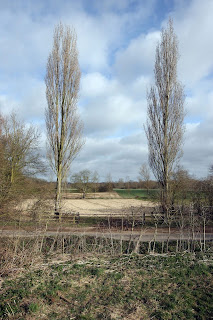In 1944 Eric was undertaking Royal Observer Corps duty at an observation post at Great Horkesley in Essex, which looked out over the River Stour Valley to Stoke by Nayland Church - a favourite subject of Constable’s. Rudsdale wrote in his diary on 2nd September 1944 that during his observation duties:
Just occurred to me that the view due north from the post, to Stoke by Nayland, is almost the same as Constable’s view in the painting in the National Gallery [‘The Cornfield’]. He must have sat in the fields somewhere below the post.
An investigation of the site that Eric describes bears some striking similarities to Constable’s painting. There is a stream on the left of the view from which the boy in the painting quenches his thirst. The River Stour weaves its way along the bottom of the valley in both the view today and in Constable’s painting. The church in the centre of the painting was repositioned by Constable in his final painting but his preparatory works for ‘The Cornfield’ show Stoke by Nayland Church on the horizon where it can still be glimpsed today, see 'A Cornfield' in the Tate Gallery.

View of the River Stour Valley today, as identified by Eric Rudsdale as a possible location for Constable's 'The Cornfield' (1826). Photograph by M. Lees / Essex County Council.
Rudsdale was very familiar with Constable’s works and went on to discover and identify thirteen Constable sketches of Colchester in the Victoria & Albert Museum, one of which was a rare depiction of the remains of Colchester’s Roman East Gate.
The actual location of 'The Cornfield' has always been a matter of some debate. A letter that appeared in 'The Daily Telegraph' on this subject on 30th January 2010 prompted me to write about Rudsdale's discovery of a possible site for this painting (see 2nd February 2010 ), and further information appeared on 3rd February 2010. CP

No comments:
Post a Comment